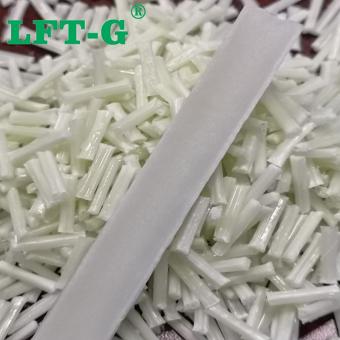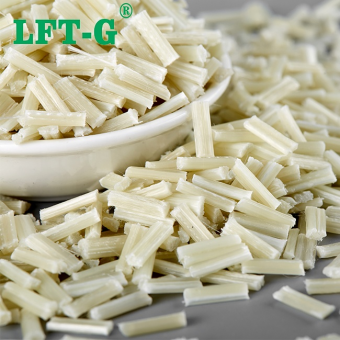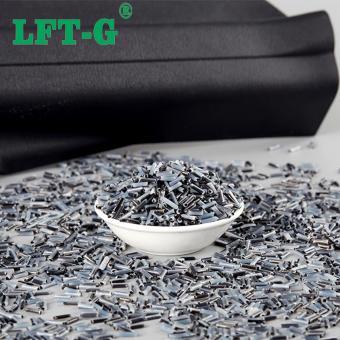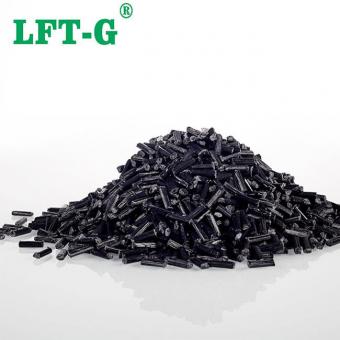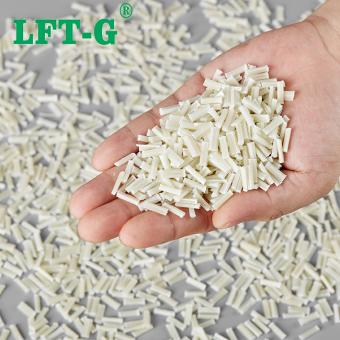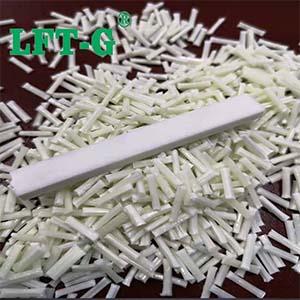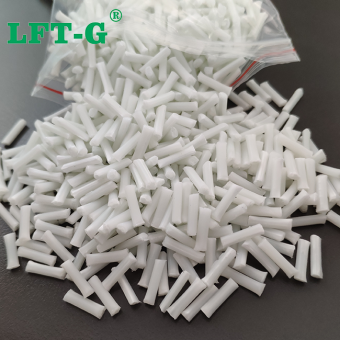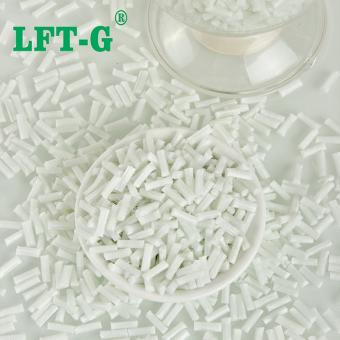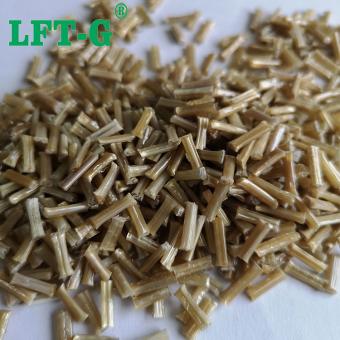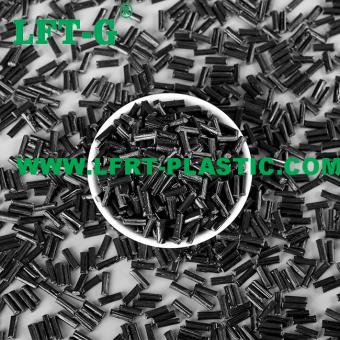-
Xiamen LFT-G MXD6 meta-xylylene adipamide nylon Long glass fiber filling 30% high barrier propertiesWhat is MXD6? Conventional aliphatic nylon is easy to process but has strong water absorption and low glass conversion temperature. Although all-aromatic nylon has solved the shortcomings of aliphatic products to a large extent, the processing difficulty has increased exponentially. After 1972, Toyo Textile and Mitsubishi Gas Chemical synthesized a new kind of semi-aromatic nylon MXD6, which not only overcame the disadvantages of aliphatic and all-aromatic resins to a large extent, but also had some advantages of all-aromatic resins. It is widely used in packaging materials with high gas barrier and engineering structural materials. In summary, MXD6 has the following advantages: High strength and elastic modulus; The high glass transition temperature is 237℃ for Tm and 85℃ for Tg. Low water absorption and moisture permeability; Fast crystallization speed, easy to form and manufacture; Excellent gas barrier performance. Why add Long Glass Fiber? Long glass fiber reinforced composite can solve your problems when other methods of reinforced plastics do not provide the performance you need or if you want to replace matal with plastic. Long Glass Fiber reinforced composites can cost-effectively reduce the cost of goods and effectively improve the mechanial properties of engineering internal skeleton network. Performance is preserved in a wide range of environments. MXD6 performance and application Compared with other materials, MXD6 has the advantages of high strength and elastic modulus, high glass transition temperature, low water absorption and moisture permeability, fast crystallization speed, convenient molding and manufacturing, excellent gas barrier properties, and can also be a good barrier to carbon dioxide and oxygen even under high humidity. In the end market, MXD6 is rarely used alone and is generally added to other polymers as a modified component. Materials containing MXD6 are mainly used in automotive and packaging fields. As an engineering plastic, MXD6 can replace the use of metal materials in the automotive industry, such as power tools, magnetic materials, automotive shell, chassis, girders, engine accessories, etc. We will offer you: 1) LFT & LFRT material technical parameters and leading edge design; 2) Mold front design and recommendations; 3)Provide technical support such as injection molding and extrusion molding. System Certification Quality Management System ISO9001/1949 Certification National Laboratory Accreditation Certificate Modified Plastics Innovation Enterprise Honorary Certificate Heavy metal REACH & ROHS testing
- New material MX-Nylon plastic
- Polycondensation product mxd6
- Crystalline polymer reinforced plastic
- Special nylon Polyxylylene
- Polyamide fibre made in China
- Long glass fiber composite
Tags :
-
LFT-G Polyamide 66 with addition long glass fiber 20%-60% reinforced plastic as a replacement for metalWhat is Polyamide 66 materials? PA66, abbreviation of Polyamide 66, chemical name polyhexanediylhexanediamine, commonly known as nylon 66. It is a colorless transparent semi-crystalline thermoplastic polymer, widely used in automotive, electrical and electronic appliances, mechanical instruments and meters, industrial parts and other industries. However, due to the high water absorption, poor acid resistance, low impact strength in dry state and low temperature, and easy to deform after absorbing water, which affects the dimensional stability of the products, the scope of its application has been limited to a certain extent. In order to improve the above shortcomings, expand its field of application, and better meet the requirements for the use of performance, people use a variety of methods to modify PA66, in order to improve the impact, heat deformation, molding and processing performance and chemical corrosion resistance of PA66 plastic. As the specific strength and Young's modulus of glass fiber (GF) is 10-20 times larger than PA66, the coefficient of linear expansion is about 1/20 of PA66, the water absorption rate is close to zero, and there is good heat and chemical resistance, etc., so the glass fiber filling is the most commonly used means of enhancement and modification of PA66. Polyamide 66 fillin long glass fiber compounds Why do we use LFT plastics instead of metal? Many components that are currently manufactured in metal can be produced at lower cost and lower weight in high strength plastics. Compared to metals, plastics offer a number of significant advantages: • Faster production cycles • Lower investment in equipment and tooling • Elimination of finishing operations, such as machining or painting • No corrosion problems • Tighter tolerances • Easier assembly What is the difference between Long glass fiber and Stardard glass fiber? Long glass fiber (LGF) typically contain glass fibers with lengths of 10 to 12 mm, versus 0.7-mm fibers in standard glass-reinforced compounds. In the composite material made of fibers is sheared or pulled, the fibers are pulled out from the matrix, such a pulling process is conducive to the absorption of energy provided by the loading, the longer the fibers are within a certain length, the greater the absorption of energy, and the more significant its strength. And in the same volume amount, due to the longer the single fiber, the fewer the number of fiber roots, the less stress concentration generated at the fiber end, the more difficult the destruction of the material. From the results of practical application feedback, the various properties of long glass fiber reinforced thermoplastic composites are more excellent than Standard glass fiber. In addition, glass fiber reinforced composites in the friction process, the fiber body plays an important role in lubrication, long glass fiber can be much more sustainable, stable lubrication, so the coefficient of friction is lower, less wear, and the formation of the abrasive debris is finer. Because of these advantages, long glass-fiber reinforced thermoplastic composites perform better in real-world applications without fear of high frequencies and high loads. What is the advantages of Polyamide 66? Nylon 6/6 is composed of a molecular structure of higher order than Nylon 6, heightening Nylon 6’s positive characteristics: higher tensile strength and stiffness, better dimensional stability, and a higher melting point. Nylon 6/6 has a high lubricity and resistance to hydrocarbons; and exceptionally balanced strength, ductility, and heat resistance. As strong as it is independently, adding fillers, fibers, lubricants, and impact modifiers can increase Nylon 6/6’s strength times five and stiffness times ten. TDS of 30% long stand fiber glass reinforced Polyamide 6.6 All TDS with 20%-60% fiber specification, please aks technologists What are the applications of Nylon 66 filling long stand fiber glass pellets? Frequently asked questions Q. Does long glass fiber and long carbon fiber injection have special requirements for injection molding machines and molds? A. There are certainly requirements. Especially from the product design structure, as well as the injection molding machine screw nozzle and mold structure injection molding process must consider the requirements of long fiber. Q. Using a long fiber reinforced thermoplastic material, will it block the die hole due to the long length of the fiber or not? A. When using long glass fiber or long carbon fiber, it is necessary to evaluate whether the product is suitable for LFT-G. If the product is too small or the dispensing is not suitable for long fiber materials. The long fiber itself has requirements for mold nozzle. Q. How to choose the rei...
- engineering thermoplastics PA66
- long glass fiber reinforced thermoplastic resin pa66
- heat deflection temperature pa66 gf
- Nylon 66 comounds more dystaline
- injection molded high stiffness and tensile
- gf filled plastic pa66 natural color
Tags :
-
LFT-G Polypropylene long carbon fiber modified plastic higher strength original color for car partsCarbon Fiber Reinforced Plastic Carbon fiber reinforced plastic composite (CFRP) is a lightweight, strong material that can be used to make a wide range of products used in everyday life. It is a term used to describe fiber reinforced composites with carbon fiber as the main structural component. Note that the "P" in CFRP can also stand for "plastic" rather than "polymer." Typically, CFRP composites use thermosetting resins such as epoxy, polyester, or vinyl esters. Despite the use of thermoplastic resins in CFRP composites, "carbon fiber reinforced thermoplastic composites" often uses its own acronym, CFRTP composites. LFT-G focuses on LFT&LFRT. Long Glass Fiber Series (LGF) & Long Carbon Fiber Series. Compared with Short Carbon Fiber, Long Carbon Fiber has more excellent performance in mechanical properties. It is more suitable for large products and structural parts. It has 1-3 times higher (toughness) than Short Carbon Fiber, and the tensile strength(strength and rigidity) is increased by 0.5-1 times. Properties of CFRP composites Composites reinforced with carbon fiber are different from other FRP composites that use traditional materials such as glass fiber or arylon fiber. Advantages of CFRP composites include: Light weight: Conventional fiberglass reinforced composites using continuous fiberglass and 70% fiberglass (glass weight/gross weight) typically have a density of 0.065 lb/cubic inch. A CFRP composite with the same 70% fiber weight might typically have a density of 0.055 lb/cubic inch. Increased strength: Carbon fiber composites not only weigh less, but CFRP composites are stronger and stiffer per unit weight. This is true when comparing carbon fiber composites to glass fibers, and even more so when comparing metals. For example, when comparing steel to CFRP composites, a good rule of thumb is that a carbon fiber structure of the same strength typically weighs 1/5 as steel. You can imagine why car companies are looking into using carbon fiber instead of steel. When comparing CFRP composites to aluminum (one of the lightest metals used), the standard assumption is that an aluminum structure of the same strength might weigh 1.5 times as much as a carbon fiber structure. Of course, there are many variables that can change this comparison. Grades and qualities of materials may vary, and for composites, the manufacturing process, fiber structure and quality need to be considered. Disadvantages of CFRP composites Cost: As amazing as the material is, there's a reason carbon fiber can't be used in every situation. Currently, the cost of CFRP composites is too high in many cases. Depending on current market conditions (supply and demand), the type of carbon fiber (aerospace grade versus commercial grade), and bundle size, carbon fiber prices can vary significantly. On a per-pound basis, carbon fiber can cost anywhere from five to 25 times more than fiberglass. The difference is even greater when comparing steel with CFRP composites. Electrical conductivity: This can be a plus or minus for carbon fiber composites, depending on the application. Carbon fiber is extremely conductive, while glass fiber is insulating. Many applications use fiberglass instead of carbon fiber or metal, strictly because of electrical conductivity. For example, in the utility industry, many products require the use of fiberglass. This is one of the reasons why the ladder uses fiberglass as the ladder rail. The chance of electric shock is much lower if the fiberglass ladder comes into contact with the power cord. The situation with CFRP ladders is different. Although the cost of CFRP composites remains high, new technological advances in manufacturing are continuing to provide more cost effective products. Application of PP-LCF Long Carbon Fiber as the reinforcement material of CFRP, its proportion is only 1/4 of iron, specific strength is 10 times that of iron, elastic modulus is 7 times that of iron, carbon fiber excellent physical properties are played in various fields from sports goods to aircraft. Details of product Number Length Color Sample Package Delivery time Port of Loading Freight PP-NA-LCF30 5-25mm Original color (can be customized) Available 20kg a bag 7-15days after shipment Xiamen Port Depending on your destination Related products PA6-LCF PA66-LCF About Xiamen LFT Composite plastic Co., Ltd. A new material enterprise that develops and produces its own brand of LFT long glass fiber and long carbon fiber. It fills the blank of domestic high-end long carbon fiber LFT materials, and is more customized and shortened the production cycle compared with foreign companies. In addition, our company has sales and service offices in Zhejiang, Jiangsu, Guangzhou, Chongqing, etc. ...
- Long fiber reinforced thermoplastics
- Modified materials of long carbon fiber
- Homopolymer long carbon fiber PP
- The modified PP thermoplastics
- Long carbon fiber filling plastic machinery
- LFT-G brand materials translucent parts, housewares, furniture PP
Tags :
-
LFT-G Polyamide 12 long carbon fiber filled modified nylon12 high impact resistance and toughnessLong carbon fiber Carbon fiber has many excellent properties, high axial strength and modulus, low density, high specific performance, no creep, super high temperature resistance in non-oxidizing environment, good fatigue resistance, specific heat and electrical conductivity between non-metal and metal, small coefficient of thermal expansion and anisotropy, good corrosion resistance, good X-ray transmission. Good electrical and thermal conductivity, good electromagnetic shielding, etc. Compared with traditional glass fiber, carbon fiber has more than 3 times of Young's modulus; it is about 2 times of Young's modulus compared with Kevlar fiber, which is insoluble and swollen in organic solvents, acids and alkalis, and has outstanding corrosion resistance. But is there a way to reduce the price of carbon fiber? That is to mix it with relatively cheap nylon material to form a composite material with good performance and meet the requirements. In that case, there is no doubt that carbon fiber nylon will definitely have a place in the composite material. Nylon itself is an engineering plastic with excellent performance, but moisture absorption, poor dimensional stability of products. Strength and hardness are also far from metal. In order to overcome these shortcomings, as early as before the 70s. People have used carbon fiber or other varieties of fibers for reinforcement to improve its performance. Carbon fiber reinforced nylon materials have developed rapidly in recent years, because nylon and carbon fiber are excellent performance in the field of engineering plastics materials, its compound material synthesis reflects the superiority of the two, such as strength and rigidity than unreinforced nylon is much higher, high temperature creep is small, thermal stability has improved significantly, good dimensional accuracy, wear resistance. Excellent damping, compared with glass fiber reinforced has better performance. Therefore, carbon fiber reinforced nylon (CF / PA) composites have developed rapidly in recent years. And for 3D printing using SLS technology is the most suitable technical means to achieve carbon fiber reinforced nylon. TDS for reference Application Our company Xiamen LFT composite plastic Co., Ltd is a brand-name company that focuses on LFT&LFRT. Long Glass Fiber Series (LGF) & Long Carbon Fiber Series (LCF). The company's thermoplastic LFT can be used for LFT-G injection molding and extrusion, and can also be used for LFT-D molding. It can be produced according to customer requirements: 5~25mm in length. The company's continuous infiltration reinforced thermoplastics have passed ISO9001&16949 system certification, and the products have obtained lots of national trademarks and patents.
- long fibre reinforced thermoplastics resin pa12
- carbon fiber reinforced plastics granules
- long carbon fiber reinforced pa12
- thermoplastic Polyamide 12 natural color with addition fiber
- wear resistance injection molding pa12 gf
- pa12 lcf for car parts
Tags :
-
Xiamen LFT Polyetheretherketone CF composite 20%-60% high performance natural colorProduct grade: General grade Fiber specification: 20%-60% Product feature: Flame resistant, Heat resistant, Chemical resistant, Low friction coefficient, Good load bearing Product application: Aviation, Machinery, Electronics, Chemicals, Automotive, Other high-tech fields.
- Good load bearing polyetheretherketone
- Low friction coefficient made bu own factory
- Own factory made pure and virgin peek
- Wide useage peek industrial materials reinforced peek
- Customized materials peek toughness Carbon
- Long Glass Fiber can be recycled peek aerospace
Tags :
-
Xiamen LFT-G Polyamide 66 long glass fiber reinforced thermoplastic compounds high strengthWhat is PA66? PA66, abbreviation of Polyamide 66, chemical name polyadiptyl adiptyl diamine, commonly known as nylon 66. Is a colorless transparent semi-crystalline thermoplastic polymer, widely used in automobiles, electronic appliances, mechanical instruments, industrial parts and other industries. What is PA66-LGF? However, due to the large absorbency of nylon itself, poor acid resistance, low impact strength of dry state and low temperature, and easy deformation after water absorption, the dimensional stability of the product is affected, so that its application range is limited to some extent. In order to improve the above shortcomings, expand its application field, and better meet the requirements of performance, people adopt a variety of methods to modify PA66 plastic, so as to improve the impact property, thermal deformation property, forming processing property and chemical corrosion resistance. Because the specific strength and Young's modulus of glass fiber (LGF) are 10~20 times larger than that of PA66, the linear expansion coefficient is about 1/20 of that of PA66, the water absorption is close to zero, and it has good heat and chemical resistance, glass fiber filling is the most commonly used enhancement modification method of PA66. PA66 is the variety with the highest mechanical strength and the most widely used in PA series. Because of its high crystallinity, it has high rigidity and heat resistance. TDS of Polyamide 66 filling LGF Translucent or opaque opalescent crystalline polymer with plasticity. It has excellent wear resistance, self lubricity and high mechanical strength. Application 1. The automobile industry Because of its excellent heat resistance, chemical resistance, strength and convenient processing, nylon 66 has been widely used in the automobile industry. At present, it can be used in almost all parts of the automobile, such as the engine parts, electrical parts and body parts. The engine part includes the intake system and the fuel system, such as the engine cylinder head cover, throttle, air filter machine housing, vehicle air horn, vehicle air conditioning hose, cooling fan and its housing, water inlet pipe, brake oil tank and cover, and so on. Body parts include: car fender, rear view mirror frame, bumper, dashboard, luggage rack, door handle, wiper bracket, seat belt buckle, interior decoration and so on. Car electric appliances such as electric control doors and Windows, connectors, crisper, cable tie wire. 2. Electronic and Electrical industries PA66 can produce electronic and electrical insulation parts, precision electronic instrument parts, electrical lighting appliances and electronic and electrical parts, can be used to make rice cookers, electric vacuum cleaners, high-frequency electronic food heaters, etc. PA66 has excellent solder resistance and is widely used in the production of junction boxes, switches and resistors. Flame retardant grade PA66 can be used for color TV wire clip, fixing clip and focusing knob. 3. Machinery transportation and machinery and equipment industry PA66 can be used for door handles of passenger cars and brake joint discs of freight cars. Other products such as insulation washer, baffle seat, turbine, propeller shaft, screw propeller and sliding bearing on ship can also be made with PA66. High impact resistance nylon 66 can also be made pipe pliers, plastic molds, radio control body, etc. Unreinforced grade nylon 66 is usually used to manufacture nuts, bolts, screws, nozzles, etc. with low creep and no corrosion. Reinforced grade nylon 66 used in the production of chains, conveyor belts, fan blades, impeller and scaffolding fixed foot buckle. Details Number Color Length MOQ Package Sample Delivery time Port of Loading PA66-NA-LGF30 Original color or Customized 6-25mm 25kg 25kg/bag Available 7-15 days after shipment Xiamen Port Frequently asked questions 1. How to choose the fiber content of the product? Is the larger product suitable for higher fiber content material? A. This is not absolute. The content of glass fiber is not more is better. The suitable content is just to meet the requirements of each products. 2. Can products with appearance requirements be made of long-fiber materials? A. The main feature of LFT-G thermoplastic long glass fiber and long carbon fiber is to show the mechanical properties. If the customer has bright or other requirements for the appearance of the product, it needs to be evaluated in combination with specific products. 3. How to choose the reinforcement method and length of the material when using long fiber reinforced thermoplastic material? A. The selection of materials depend on the requirements of the products. It is necessary to assess how much the content is enhanced and how much length is more appropriate, which are depending on the performance requirements of the products.
- Polyamide 66 lgf filling lgf high rigidity
- long glass fiber polyamide66 instead metal steel
- pa66 lgf30 car parts and other products
- long fibre reinforced thermoplastics nylon 66
- long fiber compounds pa66 cut down cost
- polyamide 6.6 lgf30 GF
Tags :
-
Xiamen LFT-G TPU filling Long glass fiber reinforced compounds for engineering useWhat is the TPU material? TPU is thermoplastic polyurethane, which is a kind of polyurethane that can be plasticized by heating and dissolved by solvent. Compared with the mixed and cast polyurethane, the chemical structure of thermoplastic polyurethane has no or little chemical crosslinking, its molecules are basically linear, but there is a certain amount of physical exchange. The concept of physical exchange, as it is called, was developed in 1958 by SchollenbergeC. First of all, it is proposed that there is a "connection point" between linear polyurethane molecular chains that is reversible in the presence of heat or solvent, which is not actually chemical crosslinking, but plays the role of chemical crosslinking. Due to this physical crosslinking, polyurethane has formed the theory of polyphase morphology structure. The hydrogen bond of polyurethane strengthens its morphology and makes it withstand higher humidity. According to soft segment structure can be divided into polyester type, polyether type and butadiene type, they contain ester group, ether group or butadiene group respectively. According to the hard segment structure, they can be divided into aminoester type and aminoester urea type, which are obtained from diol chain extender or diamine chain extender, respectively. The common division is polyester type and polyether type. Why filling Long Glass Fiber? Long glass fiber reinforced composites can solve your problems when other methods of reinforced plastics do not provide the performance you need or if you want to replace the metal with plastic. Long glass fiber reinforced composites can cost-effectively reduce the cost of goods and effectively improve the mechanical properties of engineering polymers, and increase the durability by forming long fibers to form a long-fiber-reinforced internal skeleton network. Performance is preserved in a wide range of environments. TDS of TPU-LGF Application Details Xiamen lft composite plastic Co., Ltd Xiamen LFT Composite Plastic Co.,LTD was established in 2009, is a brand-name global suppliers of long fiber reinforced thermoplastic materials integrating product research & development(R&D), production and sale marketing. Our LFT products have passed the ISO9001&16949 system certification and have obtained lots of national trademarks and patents, covering the fields of automotive, military parts and firearms, aerospace, new energy, medical equipment, power wind energy, sports equipment, etc.
- Thermoplastic Polyurethane lgf
- lft-g tpu resin glass fiber shoes toes
- tpu reinforced lgf instead of metal
- tpu composite material manufacturer price
- long glass fiber tpu China supplier
- tpu modified material lgf industrials use
Tags :
-
Xiamen LFT-G Acrylonitrile Butadiene Styrene ABS filling long glass fiber modified plastic 12mmWhat is ABS? ABS (ABS is the acronym of Acrylonitrile Butadiene Styrene copolymer), also known as ABS resin, is a kind of thermoplastic polymer structural material with high strength, good toughness and easy to be machinated. ABS engineering plastic appearance is opaque ivory grain, its products can be colorful, and has high gloss. Why filling Long glass fiber? LFT & LFRT, Long fiber reinforced thermoplastic engineering plastics, compared to conventional short fiber reinforced thermoplastis, typically have a fiber length of less than 1 to 2 mm in conventional short fiber reinforced thermoplastics, while the LFT process the thermoplastic engineering plastics produced have been able to maintain fiber lengths above 5 to 25 mm. The long fiber is impregnated with a specail resin system to obtain a long strip which is suffciently wetted by the resin, and then cut into a desired length as required. According to the final different applications, the finished product can be used foe injection molding, extrusion and molding, Etc., directly used to replace steel and thermoset products. Advantages of ABS-LGF 1 glass fiber reinforced, glass fiber is a high temperature resistant material, therefore, the heat resistant temperature of reinforced plastic is much higher than before without glass fiber, especially nylon plastics. 2. After glass fiber reinforcement, due to the addition of glass fiber, the mutual movement between polymer chains of plastic is limited, therefore, the shrinkage rate of reinforced plastics decreases a lot, and the rigidity is greatly improved. 3. After glass fiber reinforcement, reinforced plastics will not stress crack, at the same time, the anti-impact performance of plastics is improved a lot. 4. After glass fiber reinforcement, glass fiber is a high strength material, which also greatly improves the strength of plastic, such as: tensile strength, compression strength, bending strength, improve a lot. 5. glass fiber reinforced after, due to the addition of glass fiber and other additives, the combustion performance of reinforced plastics decreased a lot, most of the material can not ignite, is a kind of flame retardant material. Datasheet for reference Application of ABS-LGF Mainly used in load-bearing parts and structural parts Details you may wonder Number Length Color MOQ Package Sample Delinery time Port of Loading ABS-NA-LGF30 5~25MM above Original color (can be customized) 25kg 25kg/bag Available 7~15 days after shipment Xiamen Port Our company Our teams & customers We will offer you: 1. LFT&LFRT material technical parameters and leading edge design. 2. Mold front design and recommendations. 3. Provide technical support such as injection molding and extrusion molding.
- long glass fiber Acrylonitrile Butadiene Styrene
- long fiber compounds ABS
- long fiber composite ABS granules
- long fibre reinforced thermoplastics
- ABS LGF30
- abs glass fiber
Tags :
-
Xiamen LFT-G HDPE filling long glass fiber high toughness stiffness modified pellets for shellHDPE Introduction High-density polyethylene is an opaque white waxy material, lighter than water, specific gravity of 0.941 ~ 0.960, soft and tough, but slightly harder than LDPE, but also slightly elongated, non-toxic, odorless. Flammable, can continue to burn after leaving the fire, the upper end of the flame is yellow, the lower end is blue, will melt when burning, there are liquid drops, no black smoke, at the same time, emitting the smell of paraffin wax when burning. Acid and alkali resistance, organic solvent resistance, excellent electrical insulation, low temperature, can still maintain a certain degree of toughness. Surface hardness, tensile strength, rigidity and other mechanical strength are higher than LDPE, close to PP, tougher than PP, but the surface finish is not as good as PP. Poor mechanical properties, poor air permeability, easy to deformation, easy to aging, easy to brittle, brittle than PP, easy stress cracking, low surface hardness, easy to scratch. Difficult to print, when printing, surface discharge treatment is required, can not be plated, and the surface is not glossy. HDPE-Long glass fiber Because of its high crystallinity, poor impact strength and environmental cracking resistance and other defects, limiting its scope of application, so a lot of toughening modification HDPE research work has been carried out at home and abroad. Our company has greatly improved the performance of HDPE through the way of co-blending modification. Long fiber reinforced thermoplastic composites are reinforced thermoplastics with fiber lengths greater than 10mm. The reinforcing fibers are mainly glass fibers, carbon fibers, etc. Depending on the type of resin with appropriate fiber surface treatment, better results can be achieved. The addition of fiber material to the resin can greatly improve the overall material performance. Fiber composites absorb external forces in three ways: fiber pullout, fiber breakage, and resin fracture. The increase of fiber length consumes more energy for fiber pull-out, which is beneficial to the improvement of impact strength; the end of fiber in the composite is often the initiation point of crack growth, and the small number of long fiber ends also makes the impact strength increase; the long fiber blends entangle, flip and bend each other when filling the mold, unlike the short fiber blends which are arranged in the flow direction, therefore, the long fiber blends molded products are better than the same molded parts of short fiber blends. Therefore, compared with the same molded parts of short fiber blends, the long fiber blends have higher isotropy, better straightness, less warpage, and therefore better dimensional stability; the heat deflection temperature of long fiber reinforced thermoplastics is also increased than that of short fiber blends. Therefore, long-fiber composites exhibit better performance than short-fiber composites, which can improve rigidity, compression strength, bending strength, and creep resistance. Process TDS for your reference Tests Certifications Quality Management System ISO9001/16949 Certification National Laboratory Accreditation Certificate Modified Plastics Innovation Enterprise Honorary Certificate Heavy metal REACH & ROSH testing Application We will provide technical supports according to your product's images. About us We will offer you: 1. LFT & LFRT material technical parameters and leading edge design. 2. Mold front design ang recommendations. 3. Provide technical support such as injection molding and extrusion molding. Frequently asked questions Q: How to choose the reinforcement method and length of the material when using long fiber reinforced thermoplastic material? A: The selection of materials depend on the requirements of products. It is necessary to assess how much the content is reinforced and how much length is more appropriate, which are depending on the performance requirements of the products. Q: In addition to being suitable for injection molding, long fiber products can be extruded or other processes? A: LFT long glass fiber and long carbon fiber are mainly used for injection molding, and can also extrusion plate profile tube and mold edges a variety of thermoplastic molding methods. Q: The cost of long fiber products is higher than raw materials. Does it has a high recycling value? A: The thermoplastic LFT long fiber material can be recycled and reused very well.
- long glass fiber HDPE instead metal and steel
- glass fiber reinforced plastics granules
- LFT composite PE for pipe undergrund
- HDPE LGF sample available injection mold
- Glass fiber fill hdpe virgin grade
Tags :
-
Xiamen LFT-G PPS Polyphenylene sulfide composite long glass fiber thermoplastic original colorPPS information The resin matrix of thermoplastic composites involves general and special engineering plastics, and PPS is a typical representative of special engineering plastics, commonly known as "plastic gold". Performance advantages include the following aspects: excellent heat resistance, good mechanical properties, corrosion resistance, self-flame retardant up to UL94 V-0 level. Because PPS has the advantages of the above properties, and compared with other high performance thermoplastic engineering plastics and has the characteristics of easy processing, low cost, so it becomes an excellent resin matrix for manufacturing composite materials. PPS composite material PPS filling short glass fiber (SGF) composite material has the advantages of high strength, high heat resistance, flame retardant, easy processing, low cost, and has been applied in automotive, electronics, electrical, machinery, instruments, aviation, aerospace, military and other fields. PPS filling long glass fiber (LGF) composite material has the advantages of high toughness, low warpage, fatigue resistance, good product appearance and so on. It can be used in water heater impeller, pump shell, joint, valve, chemical pump impeller and shell, cooling water impeller and shell, household appliance parts and so on. What are the specific differences between short glass fiber (SGF) and long glass fiber (LGF) reinforced PPS composites? 1. Mechanical property analysis The reinforcement fiber added in the resin matrix can form a supporting skeleton, and the reinforcement fiber can effectively bear the external load when the composite is subjected to external force. At the same time, energy can be absorbed by fracture, deformation and other ways to improve the mechanical properties of resin. The tensile strength and bending strength of the composites are gradually increased by increasing the amount of glass fiber. The main reason is that when the glass fiber content increases, more glass fiber in the composite material can withstand the action of external force. Meanwhile, due to the increase in the number of glass fibers, the resin matrix between the glass fibers becomes thinner, which is more conducive to the construction of glass fiber reinforced frame. Therefore, with the increase of glass fiber content, more stress is transferred from resin to glass fiber under external load, which effectively improves the tensile and bending properties of composite materials. The tensile and bending properties of PPS/LGF composites are higher than those of PPS/SGF composites. When the glass fiber mass fraction is 30%, the tensile strength of PPS/SGF and PPS/LGF composites is 110MPa and 122MPa, respectively. The bending strength was 175MPa and 208MPa, respectively. The flexural elastic modulus were 8GPa and 9GPa, respectively. The tensile strength, bending strength and bending elastic modulus of PPS/LGF composites are increased by 11.0%, 18.9% and 11.3% compared with PPS/SGF composites, respectively. PPS/LGF composites have higher length retention rate of glass fiber. Under the condition of the same glass fiber content, the composites have stronger load resistance and better mechanical properties. When the glass fiber content is low, the impact strength of the composite decreases. The main reason is that the lower glass fiber content cannot form a good stress transfer network in the composite material, so that the glass fiber exists in the form of defects under the impact load of the composite material, resulting in the overall impact strength of the composite material is reduced. With the increase of the glass fiber content, the glass fiber in the composite can form an effective spatial network, and the reinforcement effect is greater than that of the glass fiber tip. Under the action of external load, the external load can be transferred to the reinforced fiber better, thus improving the overall performance of the composite. In the PPS/LGF system, the length of the glass fiber is longer and the spatial network is more dense. The reinforced glass fiber has greater bearing capacity and better impact strength. When the mass fraction of glass fiber is 30%, the impact strength of PPS/LGF is increased by 19.4% from 31kJ/m2 to 37kJ/m2, and the notch impact strength is increased by 54.5%(from 7.7kJ/m2 to 11.9kJ/m2). 2. Thermal properties analysis of PPS/SGF and PPS/LGF composites When the mass fraction of glass fiber is 30%, the thermal deformation temperature of PPS/SGF composite and PPS/LGF composite reaches 250℃ and 275℃, respectively. The thermal deformation temperature of PPS/LGF composite is 10% higher than that of PPS/SGF composite. The main reason is that the introduction of glass fiber makes the network skeleton of reinforced fiber formed inside the composite material, which greatly improves the heat resistance of the composite material. The size of glass fiber in PPS/LGF is longer, and the heat resistance improvement advantage is more obvious....
- New high performance thermoplastic resin
- A crystalline polymer reinforced plastic pps
- Long glass fiber filling plastic
- Customized material PPS self factory made
- Industrial raw material thermoplastic ppa
- High impact resistance lgf
Tags :
-
Xiamen LFT-G Polyphenyl Sulfide PPS filled carbon fiber flame retardant UL-94Polyphenylene sulfide is a new functional engineering plastic.
- Polyphenyl sulfide pps high temperature resistance
- PPS plastic thermoplastic resin carbon fiber
- Composite material PPS modified plastic filament
- Filling lcf 30 LFT CFRP carbon fiber reinforced
- High flame retardant PPS self factory made
- Factory use raw material can be recycled pps
Tags :
-
Xiamen LFT Polypropylene add long carbon fiber modified plastic higher strength and rigidityCarbon Fiber Reinforced Plastic Carbon fiber reinforced plastic composite (CFRP) is a lightweight, strong material that can be used to make a wide range of products used in everyday life. It is a term used to describe fiber reinforced composites with carbon fiber as the main structural component. Note that the "P" in CFRP can also stand for "plastic" rather than "polymer." Typically, CFRP composites use thermosetting resins such as epoxy, polyester, or vinyl esters. Despite the use of thermoplastic resins in CFRP composites, "carbon fiber reinforced thermoplastic composites" often uses its own acronym, CFRTP composites. LFT-G focuses on LFT&LFRT. Long Glass Fiber Series (LGF) & Long Carbon Fiber Series. Compared with Short Carbon Fiber, Long Carbon Fiber has more excellent performance in mechanical properties. It is more suitable for large products and structural parts. It has 1-3 times higher (toughness) than Short Carbon Fiber, and the tensile strength(strength and rigidity) is increased by 0.5-1 times. Properties of CFRP composites Composites reinforced with carbon fiber are different from other FRP composites that use traditional materials such as glass fiber or arylon fiber. Advantages of CFRP composites include: Light weight: Conventional fiberglass reinforced composites using continuous fiberglass and 70% fiberglass (glass weight/gross weight) typically have a density of 0.065 lb/cubic inch. A CFRP composite with the same 70% fiber weight might typically have a density of 0.055 lb/cubic inch. Increased strength: Carbon fiber composites not only weigh less, but CFRP composites are stronger and stiffer per unit weight. This is true when comparing carbon fiber composites to glass fibers, and even more so when comparing metals. For example, when comparing steel to CFRP composites, a good rule of thumb is that a carbon fiber structure of the same strength typically weighs 1/5 as steel. You can imagine why car companies are looking into using carbon fiber instead of steel. When comparing CFRP composites to aluminum (one of the lightest metals used), the standard assumption is that an aluminum structure of the same strength might weigh 1.5 times as much as a carbon fiber structure. Of course, there are many variables that can change this comparison. Grades and qualities of materials may vary, and for composites, the manufacturing process, fiber structure and quality need to be considered. Disadvantages of CFRP composites Cost: As amazing as the material is, there's a reason carbon fiber can't be used in every situation. Currently, the cost of CFRP composites is too high in many cases. Depending on current market conditions (supply and demand), the type of carbon fiber (aerospace grade versus commercial grade), and bundle size, carbon fiber prices can vary significantly. On a per-pound basis, carbon fiber can cost anywhere from five to 25 times more than fiberglass. The difference is even greater when comparing steel with CFRP composites. Electrical conductivity: This can be a plus or minus for carbon fiber composites, depending on the application. Carbon fiber is extremely conductive, while glass fiber is insulating. Many applications use fiberglass instead of carbon fiber or metal, strictly because of electrical conductivity. For example, in the utility industry, many products require the use of fiberglass. This is one of the reasons why the ladder uses fiberglass as the ladder rail. The chance of electric shock is much lower if the fiberglass ladder comes into contact with the power cord. The situation with CFRP ladders is different. Although the cost of CFRP composites remains high, new technological advances in manufacturing are continuing to provide more cost effective products. Application of PP-LCF Long Carbon Fiber as the reinforcement material of CFRP, its proportion is only 1/4 of iron, specific strength is 10 times that of iron, elastic modulus is 7 times that of iron, carbon fiber excellent physical properties are played in various fields from sports goods to aircraft. Details of product Number Length Color Sample Package Delivery time Port of Loading Freight PP-NA-LCF30 5-25mm Original color (can be customized) Available 20kg a bag 7-15days after shipment Xiamen Port Depending on your destination Related products PA6-LCF PA66-LCF About Xiamen LFT Composite plastic Co., Ltd. A new material enterprise that develops and produces its own brand of LFT long glass fiber and long carbon fiber. It fills the blank of domestic high-end long carbon fiber LFT materials, and is more customized and shortened the production cycle compared with foreign companies. In addition, our company has sales and service offices in Zhejiang, Jiangsu, Guangzhou, Chongqing, etc. ...
- The modified PP high performance
- Long carbon fiber filling plastic PP car part use
- LFT-G brand materials pp polymer chemical resistance
Tags :

 e-mail
e-mail English
English français
français Deutsch
Deutsch русский
русский italiano
italiano español
español português
português العربية
العربية 日本語
日本語 한국의
한국의 中文
中文












